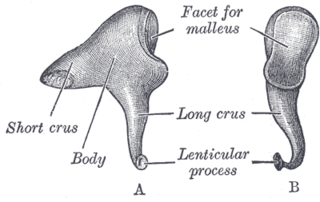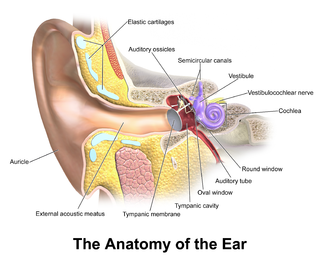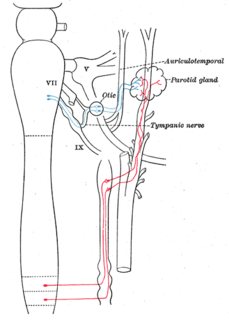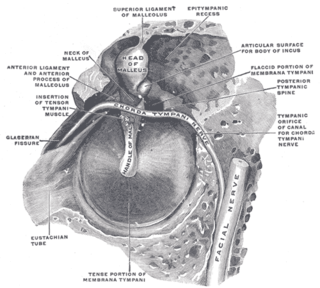
The incus or anvil is a bone in the middle ear. The anvil-shaped small bone is one of three ossicles in the middle ear. The incus receives vibrations from the malleus, to which it is connected laterally, and transmits these to the stapes medially. The incus is so-called because of its resemblance to an anvil.

The oval window is a membrane-covered opening from the middle ear to the cochlea of the inner ear.

In the anatomy of humans and various other tetrapods, the eardrum, also called the tympanic membrane or myringa, is a thin, cone-shaped membrane that separates the external ear from the middle ear. Its function is to transmit sound from the air to the ossicles inside the middle ear, and then to the oval window in the fluid-filled cochlea. Hence, it ultimately converts and amplifies vibration in air to vibration in cochlear fluid. The malleus bone bridges the gap between the eardrum and the other ossicles.

The cochlea is the part of the inner ear involved in hearing. It is a spiral-shaped cavity in the bony labyrinth, in humans making 2.75 turns around its axis, the modiolus. A core component of the cochlea is the Organ of Corti, the sensory organ of hearing, which is distributed along the partition separating the fluid chambers in the coiled tapered tube of the cochlea.

The temporal bones are situated at the sides and base of the skull, and lateral to the temporal lobes of the cerebral cortex.

The auriculotemporal nerve is a branch of the mandibular nerve (V3) that runs with the superficial temporal artery and vein, and provides sensory innervation to various regions on the side of the head.

The tympanic cavity is a small cavity surrounding the bones of the middle ear. Within it sit the ossicles, three small bones that transmit vibrations used in the detection of sound.
Augustus Quirinus Rivinus, also known as August Bachmann or A. Q. Bachmann, was a German physician and botanist who helped to develop better ways of classifying plants.

The basilar part of the occipital bone extends forward and upward from the foramen magnum, and presents in front an area more or less quadrilateral in outline.

The anterior tympanic artery is a small artery in the head that supplies the middle ear. It usually arises as a branch of the first part of the maxillary artery. It passes upward behind the temporomandibular articulation, enters the tympanic cavity through the petrotympanic fissure, and ramifies upon the tympanic membrane, forming a vascular circle around the membrane with the stylomastoid branch of the posterior auricular, and anastomosing with the artery of the pterygoid canal and with the caroticotympanic branch from the internal carotid.

The petrotympanic fissure is a fissure in the temporal bone that runs from the temporomandibular joint to the tympanic cavity.

In human anatomy, Prussak's space is the small middle ear recess, bordered laterally by the flaccid part of Shrapnell's membrane, superiorly by the scutum and lateral malleal ligament, inferiorly by the lateral process of the malleus, and medially by the neck of the malleus. From the neck of the malleus, the anterior malleolar fold and the anterior ligament arise, demarcating Prussak's space anteriorly. Ventilation of Prussak's space is only possible posteriorly above the posterior malleus fold.
Henry Jones Shrapnell (1792–1834) was an English anatomist. For a period of time during his career he was a colleague to Edward Jenner (1749–1823), creator of the vaccine for smallpox.

The following outline is provided as an overview of and topical guide to human anatomy:
The Notch of Rivinus is a small defect in the posterior edge of the bony annular tympanic ring. The defect is located just superior to the tympano-mastoid suture line in the posterior ear canal. Following identification of the spine of Henle it is possible to follow the tympano-mastoid suture line medially towards the annular ring. At this location the Chorda Tympani Nerve is often identified. Just superior to this the Notch of Rivinus can be seen and the neck of the malleus occupies the notch and often is the superior limit of a tympanomeatal flap.

The ligaments of malleus are three ligaments that attach the malleus in the middle ear. They are the anterior, lateral and superior ligaments.

Alexander Prussak was a Russian otologist.

The malleus or hammer is a hammer-shaped small bone or ossicle of the middle ear which connects with the incus and is attached to the inner surface of the eardrum. The word is Latin for hammer or mallet. It transmits the sound vibrations from the eardrum to the incus.















